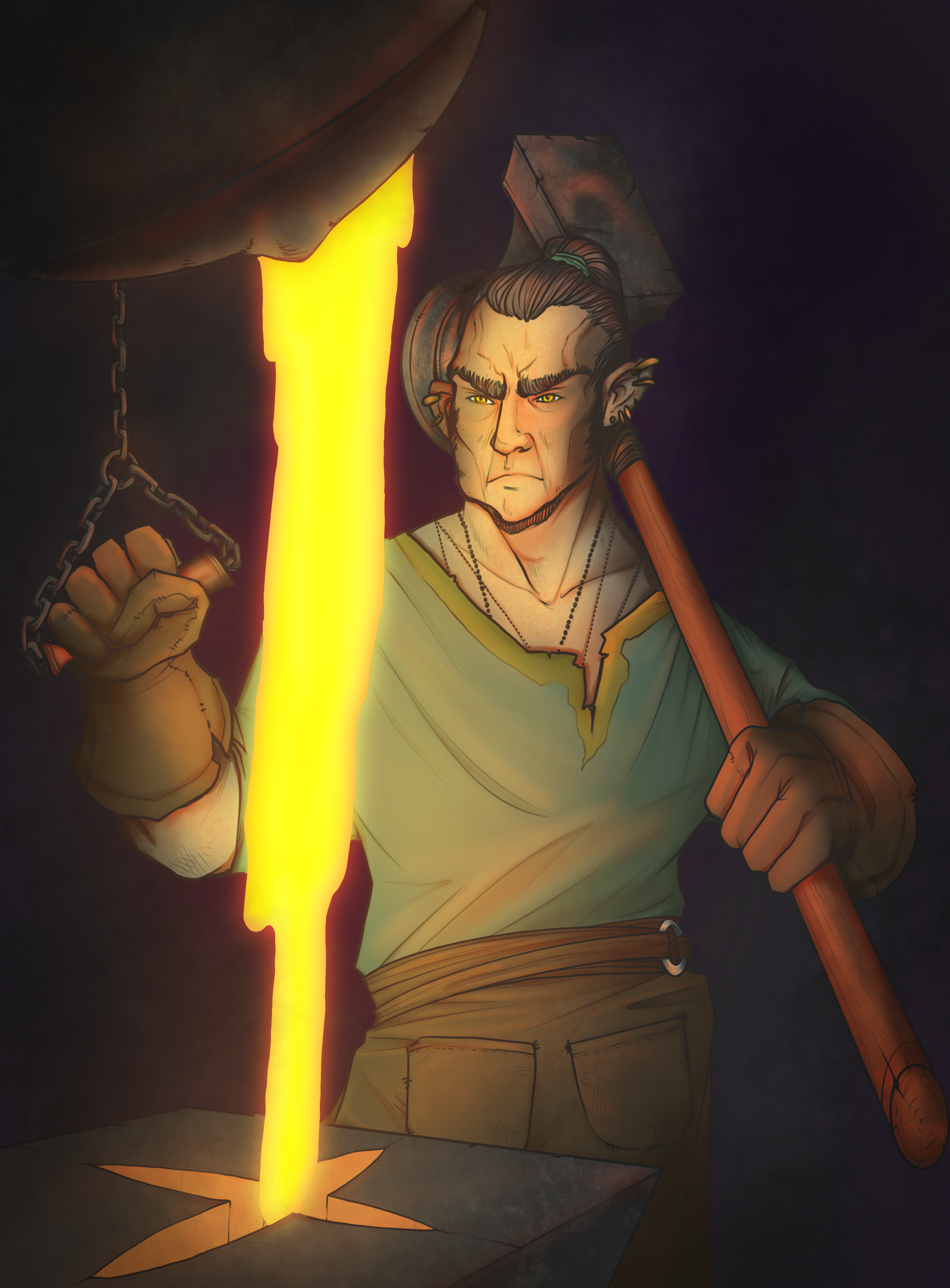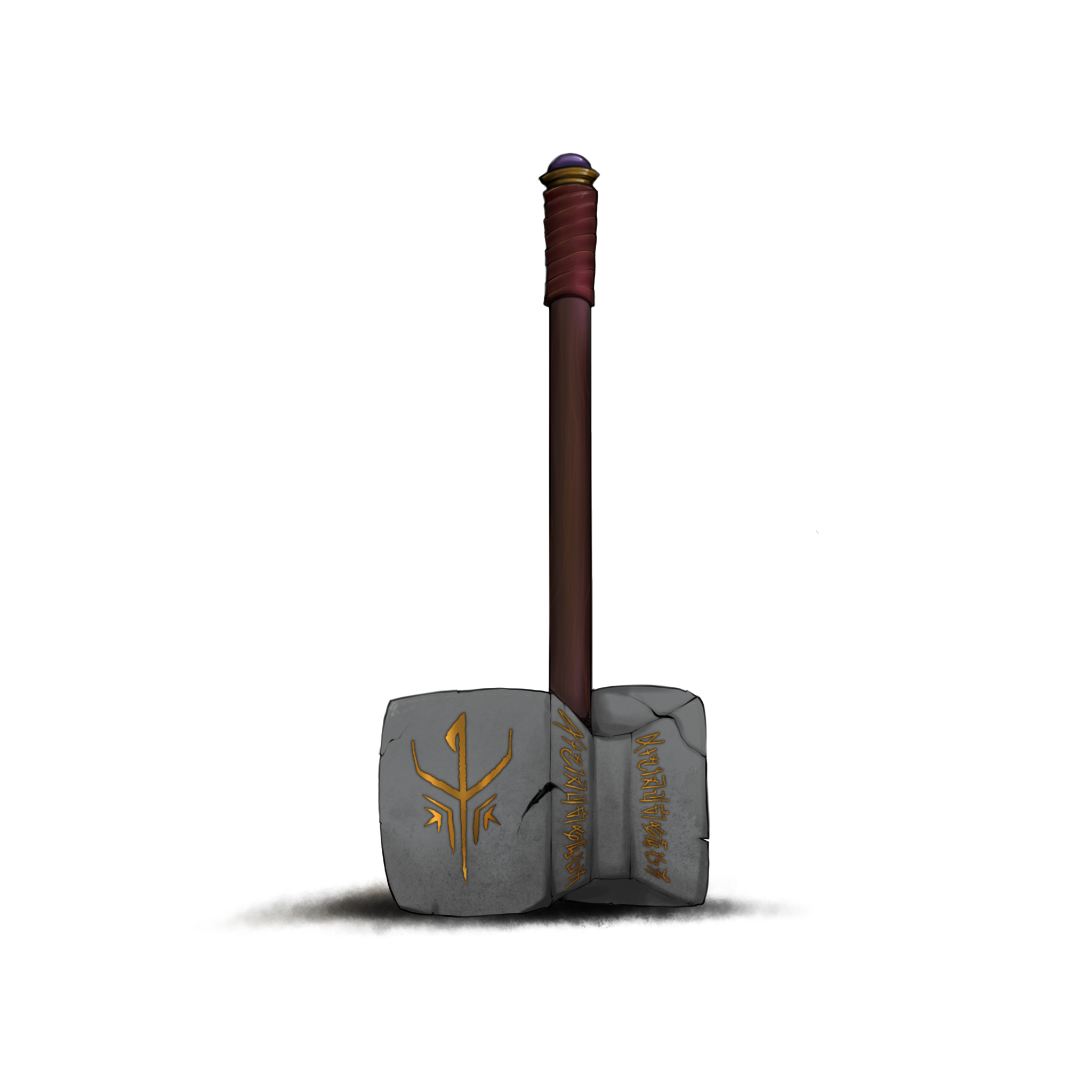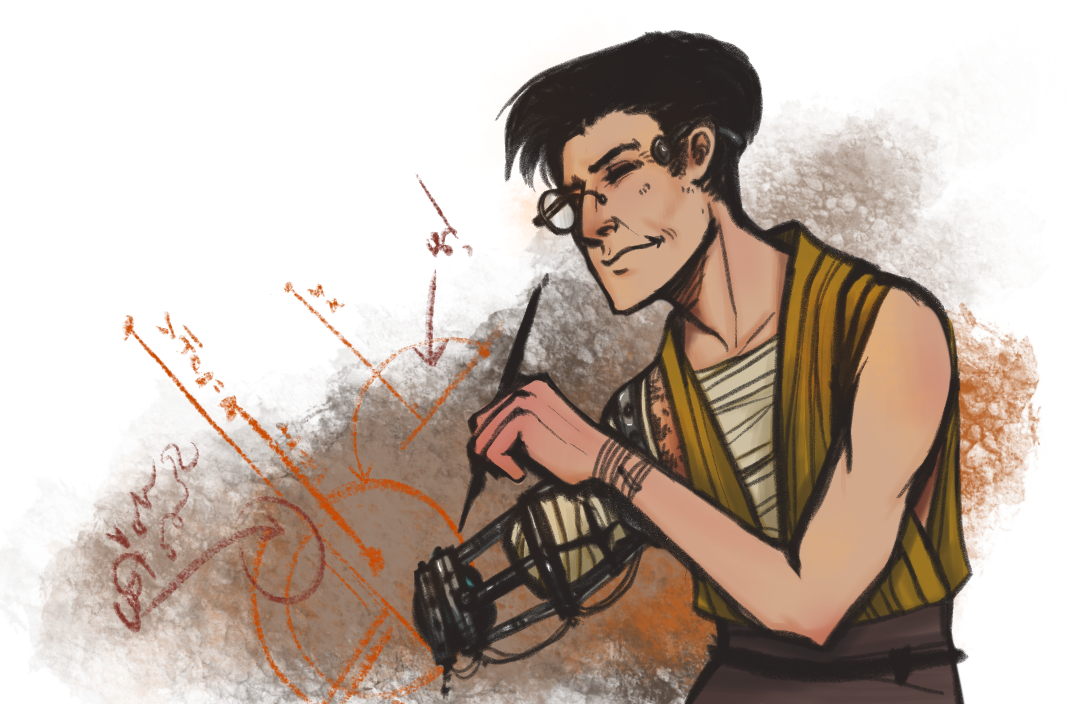Drake
Drake is the second city of the Mill Lands, but it is arguably the most strategically important. It’s furnaces and forges are heated by coals from the mining town of Mont Inaer, and its master Smiths create the largest stockpiles of arms and armour in the country. Drake, however, is primarily an exporter of weapons. Whilst weapons made of Firg steel are always sought after, a Drakish sword or axe is highly coveted.
Pelonastrans look with barely concealed contempt at Drakians, who they deride as ‘black of hand, red of brow’, suggesting that working a furnace and shovelling coal is all they are good for. Drakians normally retain a studied, grim silence when hearing such jibes. For most of the inhabitants of the Mill Lands second city, working a forge or shaping metal into new forms is the highest of virtues; their practical approach to life stems from this, and from the taciturn influence of the Firg.
Unlike many of his more foolish contemporaries, Prince Bard understands the value of Drake and fortunately the city falls under his overall stewardship, though he visits only once or twice per year.
History
Drake was established by Swithicks in the year -763 KB, as they travelled upriver from the coast using the Shay Valley as a means of traversing deeper into the interior of former Haatchi country. Initially Drake was founded on the banks of the river Shay, where the lesser river Fost feeds into it, but after two years and two terrible floods its inhabitants decided to move the settlement about a mile and a half up the Fost to higher ground. It was resettled in the shelter of a wooded dell flanked on two sides by clusters of hills.
Drake only became attractive to forgemasters much later on, when coal was discovered in the Lower Orne mountains and shipped down the Shay from Mont Inaer. Pelonastrans saw Drake as a place where industries that were unseemly in a capital city could be sent to, and the use of taxation forced the city’s smiths and forgemasters to sail northwards, carrying with them a dislike for the pretensions of Pelonastrans that exists to this day.
Before its forced relocation of industry, Drake was just a large farming town that served as the trading hub for the local area due to its position on the river. The city quickly adapted however and much of the original town was replaced by large furnace stacks and forges. The city was forced to adapt again in -167 KB after its Pelonastran Steward, Prince Rhostan Dehauer, relocated a number of businesses and citizens to build a substantial canal system through the center of the city. Hundreds of lives were lost during the construction of the canals due to the poor safety precautions and total disregard for the health of the local laborers from the steward's taskmasters. The canals are still known as the Graveways to this day.
In -65 OTM, after King Samuel II's disastrous invasion of the Molvari peninsula ended in revolution and the complete collapse of the nation of Pelonastria, the citizens of Drake had had enough of the machinations of the southern lords. The trade guilds took control of the city during the chaos, forcibly evicting any who refused to be of use to the city. The Lords of Pelonastra were enraged by these actions however, and threatened war against the city. The Guilds held fast knowing that at best any assault on the city would result in a bloody draw, and while the citizens of Drake were prepared to fight to the bitter end for the right to self governance the soldiers of Pelonastra were not.
Over the last 200 years they have developed a system where all citizens become a member of a guild at the age of 16 and work towards the betterment of the city. All property within the city is owned and maintained by the guilds, and the cost of rent for homes and businesses is incorporated into a member's guild fee's. A council of the most respected craftsmen, known as the Moot, make the crucial decisions about who the city trades with and where the profits are invested. All of the guilds are represented in the Moot, but the smith's and coker's guilds have always held the majority of seats.
The only hold over from the city’s days as a part of Pelonastria is that it still has a Steward. The hereditary position was allowed to remain in return for continued peace between Drake and the capital, but it has largely been a hollow title devoid of any weight or power. Prince Bard Rever is the first steward in over one hundred and fifty years that has taken a genuine interest in the city and has proven himself to be an ally of sorts and acts more as an ambassador for the city than a ruler. Prince Bard also serves as the Lord Defender of the Mill Lands and is often away on state business.
The City
The city, like most in the Mill Lands, straddles the river and is surrounded by walls. The main point of entry is the city’s river gates, which close and are powerfully reinforced by a series of defensive locks to prevent an attack from the river. The walls have expanded over the years and now contain many of the hills that once sheltered the earlier settlement. Industry has changed the face of this city and breathed new life into what was previously a seedy backwater. Much of where the old town used to be along the banks of the river has been replaced with workshops, forges and furnaces belching out smoke and other noxious fumes. Thick smog now settles in the low parts of the city where river mist used to cling, and the locals carry masks with them to protect their eyes and lungs from the harmful gases.
Most traffic comes into the city through the large southern river gate (Horne Gate) on rafts or barges piloted by the Ferry Folk, who serve as the primary method of importing and exporting goods along the Shay river. Unlike much of the southern Mill Lands, the Ferry Folk are welcomed within Drake’s walls and treated with respect. The Graveways, as the canals have come to be known, are in almost constant use transporting goods and resources between workshops and furnaces throughout the city.
For more land-based traffic, there is a single gate along the eastern wall, known as the Valley Gate, that leads out to the East Road going back towards the River Shay. The interior of the city is made up of three main districts: the Crucible, Stackside, and Bankhas Hill.
The Crucible is the central district of the city, it is a maze of canals, furnace stacks, forges, workshops, alleyways and warehouses that exist within the harmful and almost constant smog. This is the lowest point in the city and most of the smog collects here around the canals and river making it a dangerous place to be for a stranger to the city. The streets are lit by the hazy glow of furnaces and forges, and the din of hammer on steel can be heard day and night. The only residential buildings in the district are guild houses temporarily used by shift workers, and strangers are generally looked on with suspicion here. On the north side of the river stand the oldest forges and furnaces which were built by the Firg. While they might be less effective than they were centuries ago, they are still responsible for producing the best swords in the region.
Stackside is the northern district of the city, and makes up the vast bulk of its residential neighbourhoods. The district starts just north of the old furnace stacks with a large avenue running across the width of the city called Merchant's Way, this is where craftsmen and traders have shops and stalls to sell their wares. Above Merchant's Way the ground level rises and there is a large screening wall that shelters what was once a gated community for the wealthy that has since been opened to all. The large townhouses have been converted to apartments and are a bustling hive of activity. The gates have been removed from the screening wall to allow free access, but it still does a decent job of keeping the majority of the harmful fumes away from the houses within.
Bankhas Hill is the southern district of the city that is mainly taken up by the Bankhas, a large fort that houses the city’s garrison of soldiers as well as the only major armoury in the Mill Lands. Around the base of the fortifications are tight clusters of timber houses and a sizable plot of common land. This district contains the main abattoir and tanneries that supply the city, and is free of the smog about 60% of the time. This is the main district where outsiders would be able to find lodging at guild sponsored boarding houses or inns. The Bankhas houses the largest garrison in any city outside of Pelonastra, with soldiers from the Northern Border Horse, the Hipostic Knights, and the Trailkeepers bulking out the Reverian Guards.
Society
Drakians are practical and forward facing people who value craftsmanship and loyalty, and who look upon their southern counterparts with grim disdain. Drakian craftsmen and women often travel to Wardenhal to learn from Firg forgemasters and armourers, and as a result they consider themselves to be closer in nature to the northern arclanders than with those of the mill lands. The secret of Drakish steel is highly prized and is a jealousy guarded secret within the city. This has led to a friendly but guarded approach to outsiders within the city, that becomes outwardly suspicious and hostile if one were to be discovered in a restricted area of the Crucible.
There are five guilds that run Drake (the Smith's, Coker's, Merchant's, Engineering, and Artisan's Guilds) and each has its own designs and agendas for what is best for the city. While they do not all agree with each other's methods or see eye to eye, each guild has agreed to abide by the decisions made by the Moot, at least publicly. While the Moot makes the big decisions for the city, smaller day to day operations (such as housing, revenue, guild fee's, education, and policing) are handled internally by each guild, each has their own administrative setup and code of conduct. Whatever the differences between guilds might be though, the Moot has decreed that every citizen is entitled to decent housing and the fair wage of a Labour of silver per calendar year before guild fees as a minimum. For more information on currency see Currency in the Mil Lands.
While the majority of Citizens are satisfied by the quasi-independence that Drake has been able to achieve from the lords of Pelonastra, there is a rising undercurrent within the younger generations that believe it’s not enough however. A political group known as Drake’s Chosen is gaining support in the rougher worker’s clubs of the city, and their “Drake First” movement is calling for the complete independence of Drake and the supplanting of Pelonastra as the center of government in the Mill Lands. Drake’s Chosen is being led by a young woman named Aelean Cartwright, a charismatic firebrand in her mid to late twenties.
A Fire in the Heart of Knowing
Our debut Arclands novel is available here. Read A Fire In the Heart of Knowing, a story of desperate power struggles and a battle for survival in the dark lands of Mordikhaan.
Type
City





Comments